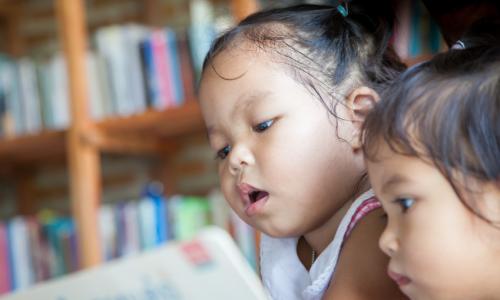Diversity is on the rise across the United States. Young children who come from homes with languages other than English are the fastest-growing segment of our population. They currently make up about a quarter of the population of children under age 9. Families and schools may turn to libraries for support of diverse languages and cultures, but are librarians ready? In this context, librarians have three main goals:
- to offer the best print and digital resources for young children and adults in the languages of the community
- to connect with diverse families in the community and encourage them to use the library
- to adapt their story times and family activities to meet the language and literacy needs of young children who speak different languages.
Partnering with local schools and childcare programs can support the library's outreach efforts and bring new ideas for serving diverse audiences. Most preschool programs use the term "dual language learner (DLL)" to describe a young child who is growing up with two or more languages. Elementary schools are more likely to use the term "English Learner (EL)" or "English Language Learner (ELL)". Some suggestions for further reading on this topic can be found at the end of this article.
What does multilingual story time look like?
Providing multilingual story time activities will help families feel more welcome to the library. When the librarian does not speak the languages in her community, how can she adapt her literacy supports to meet the needs of her families? Bilingual books, e-books and apps are a great place to start. Keep in mind that young children do not seem to benefit from hearing the reader alternate between two languages in the same sitting. It is better to let them focus on one language for an entire story and then hear the story another time in the other language.
Here are some strategies for using bilingual books effectively:
- Adults can use bilingual storybooks, especially those with sound recording, to learn key words in other languages before reading them to the children. The language is likely to be appropriate for the ages of the children, and the familiar themes make it easier for adults to learn the new words.
- Introduce the story by helping the children make connections between the key words in the different languages like this:
- "Now we are going to read Goldilocks and the Three Bears. How do we say 'bear' in Spanish? We say 'el oso.' In Spanish, the title would be "Ricitos de Oro y Los Tres Osos." How many bears? Three bears! Cuántos osos? Tres osos! And now I will read the story in English, but our Spanish-speaking friends will have a better understanding of what the story is about."
- Use more relatable props to support the meaning of the story. For example, when reading The Very Hungry Caterpillar, choose sock puppet caterpillars that can pretend to eat things rather than coloring a picture of a caterpillar that adds no meaning for children who are trying to understand the words in the story.
- Read the book in one language, then do a comprehension or extension activity, then read the book in the other language. This gives the children a chance to really focus on the words and their meanings in one language at a time as the reader uses plenty of expression and body language to support the story.
- Another approach is to read to the whole group in English, then do an activity, then hand out copies with different languages and have parents or volunteers read it again to one child or small groups in the children's home languages.
- Don't be afraid of languages you don't understand. If the book is read in English, but children make comments in their own language – that's OK! They are practicing their all-important oral language skills and enjoying the story. When adults try to pronounce words in a child's language, they may make mistakes but this gives the child a chance to be the "teacher" to the adult. It also shows the adult cares enough to risk embarrassment to show interest in the child's home language.
- Learning a new language is great brain exercise… for everyone! These strategies can also be used when reading stories in new languages to children who only speak English.
- Select books with illustrations that make sense and clearly support the story even for young children who don't understand the words. There are many beautiful books, but a librarian will have to make new choices that work better for diverse audiences. Stories with rhymes are not particularly helpful to children who speak other languages like Spanish. Stories with repeating, predictable choruses, such as The Three Little Pigs, are very helpful for diverse learners.
- If there are many bilingual books to choose from, focus on those that provide realistic language that can be used in children's everyday lives. Stories about astronauts or aliens provide less usable language than stories about friends solving problems, or children cooking with their grandparents. As children become more familiar with both languages, add more abstract books later.
- Invite bilingual volunteers to help. They might help choose books that represent not only different languages, but different cultures in appropriate ways. They can also serve as guest readers or small group story sharers.
Helping families discover what's at the library
An important part of serving a diverse community is helping diverse families understand what the library has to offer them. Engaging with families who are new to this country, new to English, and new to the kinds of libraries we have in the U.S. can be challenging - especially if they have concerns about who is "allowed" to use or even enter the library. Diverse families often have the greatest need for the kinds of supports available at responsive libraries, so meeting the challenges can yield great rewards. Where to start?
- Get to know the languages and cultures in the area. Make sure information about library services and activities is available in those languages.
- When schools set up field trips to the library, encourage them to include as many parents as possible. Teachers and librarians can both help families from other countries understand how library services can provide wonderful, free resources. (See more in these articles and tip sheets about the public library in English and Spanish from Colorín Colorado.)
- Make sure the presence of different languages, ethnicities, and cultures is represented in authentic ways as soon as people enter the building.
- Some libraries have a translation button on their website, but that doesn't necessarily show that the library is actively seeking to meet the needs of families who speak different languages. How might the website reflect a more relatable presence that shows newcomer families they are welcome? Look for diverse photos, make translated text obvious to find, and feature stories that reflect your community.
- Send representatives to local cultural fairs and events to meet families in person.
- Consider forming a committee of diverse parents who use the library regularly and ask them to serve as ambassadors in their neighborhoods to spread the word about the wealth of resources the library has for each language and cultural group. Pat Mora talks about the importance of this step in putting together a committee for planning a Día celebration in this Colorín Colorado video clip.
Inviting family members to be active readers during multilingual story time helps them learn great techniques for reading to their children. It can also help them understand the importance of maintaining the home language. Research tells us that children who receive language and literacy support in their home languages in the early years gain a stronger foundation that leads to better English development too. Multilingual story times can help all young children… and their librarians… learn new languages. Making the effort to honor the diverse languages of the community is a pathway to school readiness and academic success for all children.
Related Resources:
- White paper: The Importance of Diversity in Library Programs and Materials Collections for Children (The Association for Library Service to Children/ALSC)
- ALSC events Facebook page: Information about Día (El día de los niños/El día de los libros) for Diversity In Action
- Tip sheets for parents: Tips for reading to young children, available in 13 languages (Colorín Colorado)
- Policy brief: PreK -3rd: Challenging Common Myths about Dual Language Learners by Linda Espinosa
- Articles: Highlights from the 2014 book, Spotlight on Young Children: Supporting Dual Language Learners (National Association for the Education of Young Children)
- Guide: Selecting Culturally Appropriate Children's Books in Languages Other Than English
- New Words, New Friends: A children's story about learning to communicate with friends who speak languages other than English by Karen Nemeth
- Blog post: "Helping English language learners and their families discover the joys of the library" by Colorín Colorado Manager Lydia Breiseth
- Video clip: "Going out of the comfort zone with bilingual books" featuring author Pat Mora
About the Author
 Karen Nemeth is an author, consultant and advocate for improving early education for young children from different language backgrounds. She hosts a resource website at www.languagecastle.com.
Karen Nemeth is an author, consultant and advocate for improving early education for young children from different language backgrounds. She hosts a resource website at www.languagecastle.com.








Add new comment